The Driest Place on Earth: From Bolivia’s Salt Flats To Chile’s Atacama Desert
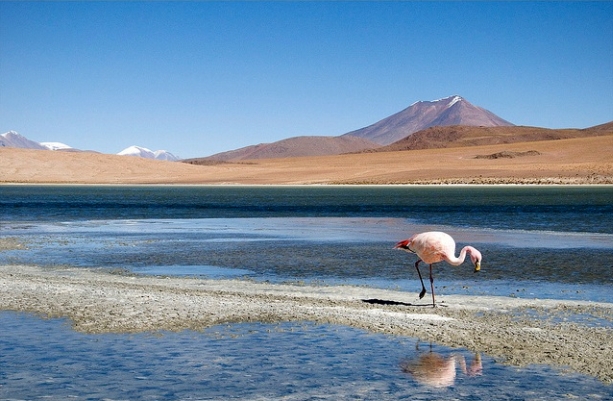
Pan-American Transmissions: Part 11
“Pan-American Transmissions” is a travel series from Special Contributor Diego Cupolo as he travels south from Nicaragua to Argentina. He has few plans, a $10-a-day budget and one flute-playing gypsy companion. Check back as new dispatches are posted from the road.
Pink flamingos wade through blood-red lagoons on a seemingly endless plateau of snow-covered volcanoes, vast salt deposits and leftovers from ancient lakes that dried long before the first human ever stepped foot on the continent. Surrounded by this panoramic gallery of Dalí paintings, I peel off the cracking skin from my knuckles and wonder, “How the hell did we get here?”
After many years spent living in crammed city apartments, Ania and I needed space — a lot of space — so we headed to the southwest section Bolivia where the Andean high plains, known as the Altiplano, meet Chile’s arid Atacama desert and spill down into the Pacific Ocean. With its rare geologic formations and an average rainfall of just one millimeter per year, the region is one of the driest, strangest places on Earth, leading many scientists to say it looks more like Mars than any part of the blue planet we call home.
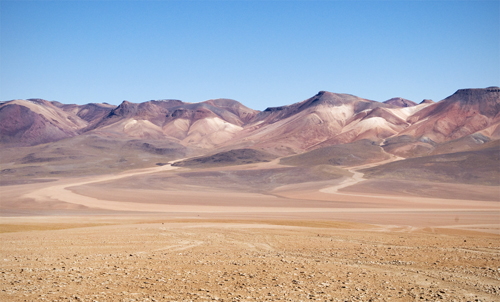
Ania and I arrived eager to get lost in other-worldly destinations like the massive salt flats of the Salar de Uyuni and jagged canyons that make up the Valle de la Luna. As we learned in the Amazon, Bolivia is a nation of extremes and the most isolated places are only accessible through tours, which is lame, but what else can a cash-strapped traveler do?
We hired a driver for a three-day desert tour to the Chilean border and when we crossed over, Ania and I took exploration into our own hands by renting mountain bikes. Both experiences had their pros and cons, but in the end, the heavy Atacama sun pounded our shoulders, the dry desert air made our skin rough like sand paper, and it was all worth it when we saw the barren desertscape turn into a kaleidoscope of purple every sunset and sunrise.
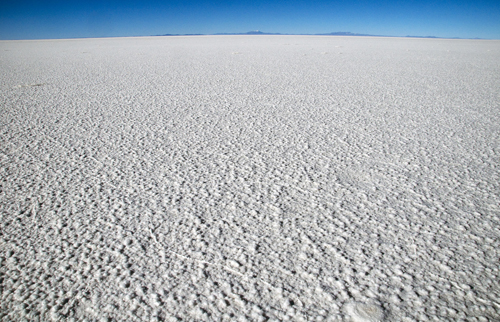
The Salar de Uyuni
Ania and I watched countless herds of llamas pass the bus window and ate even more quinoa-potato soups before we would reach the town of Uyuni and receive one crucial piece of advice: “Try to hire a tour guide that won’t drink and drive.”
As we soon found out, Salar de Uyuni tour agencies vary greatly in quality and the amount you pay is not always an indicator of the experience you’ll get. Breakdowns, flat tires, bad food, alcohol-induced accidents: a lot can go wrong on a multi-day off-road tour through the open desert.
For better or worse, we chose the Estrella del Sur agency to take us on a three-day tour through the Salar de Uyuni and Eduardo Avaroa Andean Fauna National Reserve before dropping us off at the Chilean border. Total price: $700 Bolivianos, or about USD$100 with food, accommodation and park fees included.
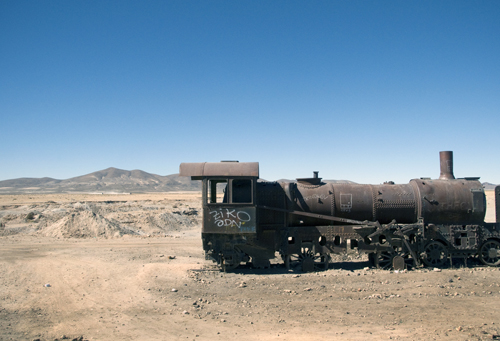
We began early in the frigid morning air. The driver pulled up in a Toyato Landcruiser. His name was Fredo and he looked sober, which was good, so we loaded the car with four Irish medical students that would make up our tour group for the next three days. Our first stop was an enormous abandoned train graveyard outside the town, an orgasm for photographers and rust enthusiasts, but Fredo told us we had 10 minutes to explore the site so we could rush to the second stop, a gift shop that sold little llamas made from salt, where we would spend half an hour.
With souvenirs tightly secured in the back, we entered the Salar de Uyuni, the largest salt flat in the world. A place is so large and so flat that Earth observation satellites use its surface to calibrate their altitude meters and global positioning systems.
According to fossil records, the Salar was part of prehistoric Lake Minchin more than 30,000 years ago. Standing at 11,995 feet above sea level, Lake Minchin would’ve competed with Lake Titicaca for highest lake in the world, but it dried up thousands of years ago, leaving behind the flat concentration of salt we see today.
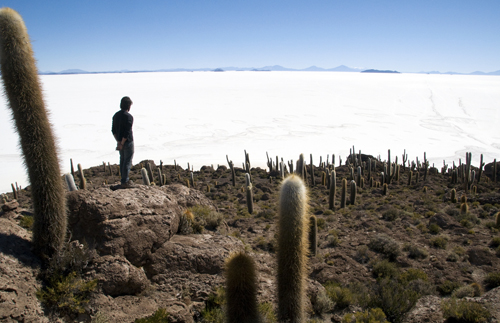
As we drove through the blinding white leftovers of history, Fredo explained the volcanoes around us used to be islands when the lake was still around. We took a chance to stop at Isla Incahuasi, one of the small “islands” in the middle of the Salar, and got out for a short hike on the rocky outcrop. Here visitors can walk over old corrals that once housed prehistoric lake creatures and stand among giant cacti that grow one meter per century. Not bad.
When we returned to the car, Fredo cooked up a few Alpaca steaks and we ate lunch as he boasted about how Alpaca meat was free of cholesterol. Not bad at all. The tour was looking good at that point.
Then the Irish students blasted Lady Gaga music in our car as Fredo rushed us out of the Salar. He said we needed to reach the hostel before sunset, which was confusing since the tour agency told us the highlight of their tour was watching the sunset from within the Salar. Basically, it was main reason to visit the salt flats and we’d be missing it. A tragic realization, but perhaps not as tragic as finding out people over the age of 20 are willfully listening to Lady Gaga.
Without stopping another time on the salt flat, we arrived at the hostel by 4 p.m. and were told dinner would be served in three hours so we could sit and have tea or something. Ania and I took the chance to run away — far, far away — from the tour group and went back into the Salar on foot.
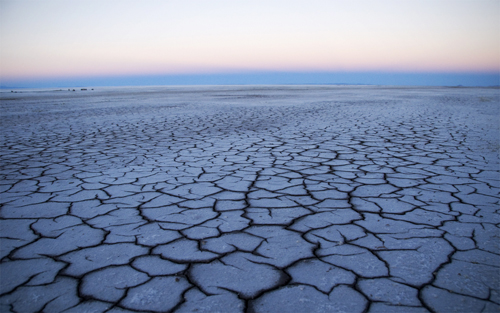
Though we didn’t get far — the place is 4,000 square miles — we did finally get some quality time with the barren land, the silence and the nothingness to contemplate very serious questions. Local legend says mankind was born from Lake Titicaca, but Ania and I figured it was more likely that our ancestors crawled out of Lake Minchin after the water dried up.
It all made perfect sense as the sun set and our shadows grew long while the sky turned into bands of orange, purple and yellow, each color reflecting off the white surface of the Salar.
“I wouldn’t mind dying here,” I thought to myself. And then it got cold and we went back to the hotel for dinner.
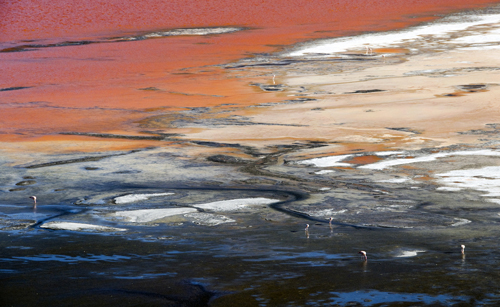
The Eduardo Abaroa Andean Fauna National Reserve
Early the next morning, Ania and I made another short trip into the Salar to watch the sun rise and have one more holy experience before breakfast. We came back frozen stiff, ate and then waited for Fredo, who showed up 30 minutes late only to take us on a short ride to the nearest store, where he would sit and talk with the owner for another 45 minutes. All the other tour groups were way ahead of us.
When he was ready, we drove quickly through a region of multi-colored lagoons with Andean flamingos wading through volcanic hot tubs and stopped briefly to take in the surreal imagery as Fredo repeated, “Come on, don’t go far from the car, we don’t have time.” I wanted to punch him in the face.
The rest of the tour pretty much went on like this. Inside the Eduardo Abaroa Andean Fauna National Reserve, we drove through some of the most beautiful scenery in the world to the soundtrack of Lady Gaga and never seemed to have enough time. Volcanos, geysers, boiling mud pits, petrified lava fields, peculiar rock formations, splashes of paint on martian landscapes — the sights were truly amazing, but less enjoyable when broken down into standardized drills: Drive, step out, take a picture, drive.
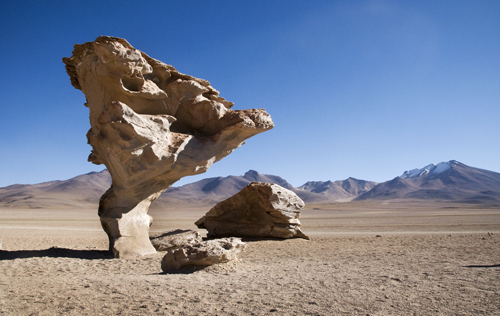
Maybe this is what the tour is supposed to be, but the other tour groups didn’t seem so rushed. Not to mention our Irish car mates’ non-stop celebrity gossiping. Oof. Maybe it was just bad luck.
The last day of the tour, I met a Chilean photographer who shared my grievances and he gave me some good advice: Take the Salar tour with a Chilean company.
This was his third time through the region (fist time with a Bolivian company) and he said Chilean agencies cost a little more, but they provide a much better tour than Uyuni-based companies. It’s the same three-day trip, only backwards so you finish at the Salar de Uyuni.
“Basically,” he said. “Chilean agencies are more likely to deliver the experience they advertise.”
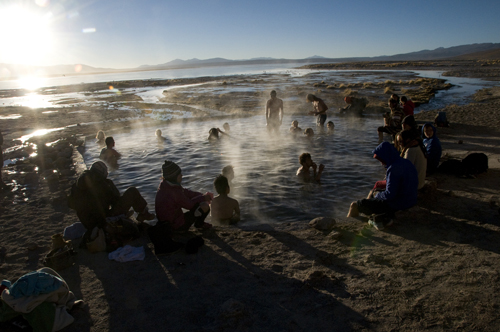
Still, the photographer was explaining all this as we sat in a natural hot spring, watching the sun rise through the steam of a distant volcano. The small inconveniences of the trip were worth the the scenery. It could’ve been much worse. We simply had high expectations for the Salar tour.
That said, Ania and I got dropped off at a lonely bus stop they called the Chilean border, and vowed never to take a tour again.
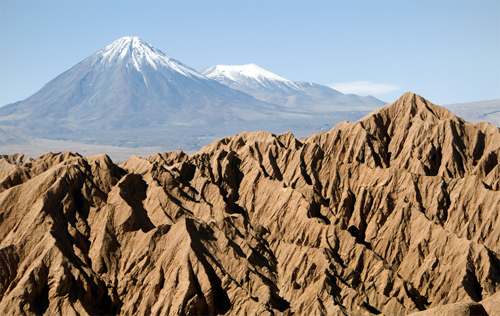
Into the Atacama Desert
An hour after descending 2,000 meters (about 1.25 miles) from the Altiplano, Ania and I reached the Chilean customs office in San Pedro de Atacama where security guards took our apples, calling them a threat to national security even though they were labeled with “Grown in Chile” stickers.
Rules, regulations, working toilets and organic flax seed granola bars — we crossed an imaginary line in the desert and everything changed. After four months in the Andes, Ania and I came down from the indigenous Altiplano and fell back into what most people would would call “Modern Western Society.”
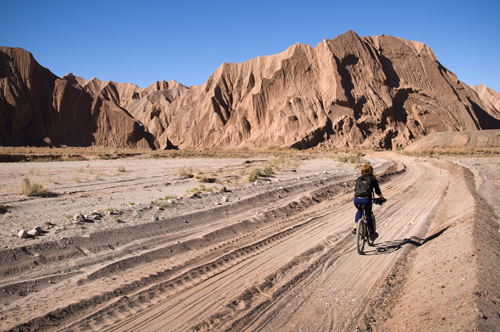
Without hesitation, we took this opportunity to rent mountain bikes. It was recommended by every traveler we crossed and costed about USD$10 for a day, so what the hell? With a map in hand, we set out for the Atacama desert on our own.
We rode through shallow rivers to a red quartz canyon they call the “Throat of the Devil.” We circled spiraling rock towers. We climbed whatever peak looked interesting and rested in whichever shade seemed inviting. It was a much easier to enjoy the landscape without a guide telling us what to do.
The main drawback to this approach is that we got lost out there. Far away objects can appear closer than they really are in wide open spaces. While trying to find the famed Valle de la Luna, we pedaled about two hours in the wrong direction. Still, in the confusion, we found a few cliffs with unforgettable views over the hypnotizing valley and enjoyed its lunar surface from above.
Sure, we never made it inside Valle de la Luna, but it didn’t matter. We were more than satisfied. This was adventure. This was the reason we had come to the Atacama, a place where the sun burns, the shade freezes and the dry air makes alligator scales out of your skin. Mars climate. Peace at last.
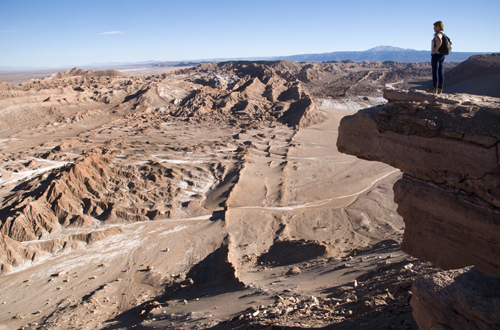
Hitchhiking South and Beyond
There’s a lot more to do in San Pedro de Atacama, but we couldn’t afford it. More salt flats, more hot springs and more geysers. It’s worth a longer visit. Instead, Ania had a plane to catch. After 10 months, our trip together was coming to an end.
With too many stories to tell, we hitchhiked to the paradise port city of Valparaiso, then Santiago, and then all the way over to Buenos Aires where we would slam on the brakes and fly through the windshield. Ania landed in plane seat back to Montreal, which was sad, and I landed in an office chair where I would work for the next five months, which was only slightly less sad.
Without a doubt, we would be reunited again, but not before I finished this long journey and reached the end of the road in Tierra del Fuego.
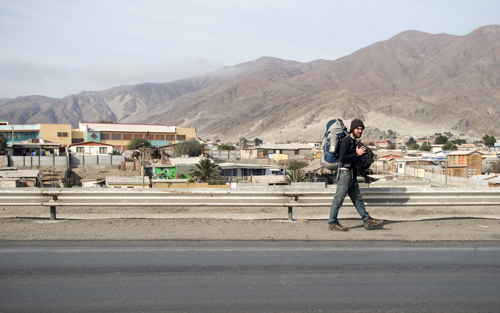
By Diego Cupolo
Coming up next, the final installment of Pan-American Transmissions: La Carretera Austral: On a Gravel Road to the End of the World.
Read all of the other Pan-American Transmissions entries here.

About the Author
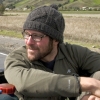 Diego Cupolo is a freelance photojournalist currently on the road to Tierra del Fuego. Most recently he served as Associate Editor for BushwickBK.com, an online newspaper in Brooklyn, and his work has appeared in The New Yorker, The Atlantic, The Star-Ledger, The Australian Times, Discover Magazine and many other publications. View more of his work at DiegoCupolo.com.
Diego Cupolo is a freelance photojournalist currently on the road to Tierra del Fuego. Most recently he served as Associate Editor for BushwickBK.com, an online newspaper in Brooklyn, and his work has appeared in The New Yorker, The Atlantic, The Star-Ledger, The Australian Times, Discover Magazine and many other publications. View more of his work at DiegoCupolo.com.
